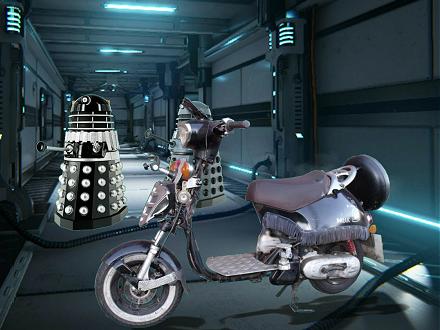So far all our New Generation bikes have been early type first-generation mini-scooters, typically with combinations of fuel tanks, oil reservoirs, and a battery beneath the seats, but a major evolutionary breakthrough in design was about to introduce a second generation of modern scooters with a helmet bin beneath the saddle. This would create enough capacity to store a crash helmet, locked, dry and secure beneath the seat for when the bike was parked, and further offered the in-built storage capacity of a typical rear box carrier when the bike was in use. To achieve this huge space bubble, the battery, fuel and oil tanks, and everything else that might be in the way would have to move elsewhere, and a completely new arrangement would also be required to make sure that engine and chassis components didn’t get in the way either.
The design of the new modern scooter would literally have to start from the concept of a helmet bin beneath the seat, and then the layout of the rest of the bike would be arranged around it.
Adding this space bubble would require a larger body shell to have a greater physical volume to contain it, which would probably also signal the end of the mini-scooter format.
An illustration of how this was achieved over 17 years ago in our Malaguti Yesterday scooter of 1999 presents the battery moved to forward of the steering headstock, the plastic moulded fuel tank in a large C-shape around the back and sides of the helmet bin, and oil reservoir tucked in forward of and above the horizontal-cylinder Minarelli 2CV 50cc motor.
Various other arrangements have been developed by different manufacturers, with the back-upright cylinder layout currently also being favoured by Peugeot, but everything always has to be laid out around the helmet-bin bubble.
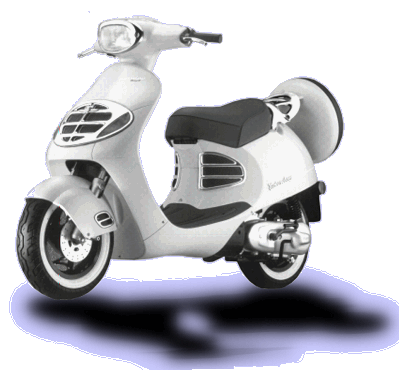
Seventeen years ago, this is what our Malaguti Yesterday
scooter originally looked like.
Its story goes that some years back … in 2013, the Yesterday was bought by a father for his daughter to ride at 16, but she took one look at it and said ‘I’m not riding that horrible thing. I’m having a car when I’m 17 instead’. Undeterred, the father decided she’d probably change her mind once he’d ‘done the bike up’ and made it look nice, so he stripped it down for restoration…
The dismantled parts had been standing out in all weathers for the last two years, the daughter had got her licence and was driving her car when, completely out of the blue, the mother said ‘That old wreck of a scooter outside my kitchen window had better be gone before you start building me a nice new patio in two weeks time’ … so it came to pass that the father and the son delivered the jumbled remains of the dismantled Malaguti scooter to the Mopedland workshops in three wheelbarrow loads in the summer of 2015.
As it happens, the workshops had for some time been toying with an idea of building an Urbo-scoot up from some suitably ruinous scooter, but had previously rejected a decrepit Gilera two-stroke as too derelict, and were entertaining the possible prospect of some cheap and tatty Baotian four-stroke which might sound more interesting if fitted with an old Triumph motorcycle silencer, but Baotian’s are a desperately tedious Chinese scooter, and now there’s a new prospect…
Our Malaguti Yesterday scooter has subsequently undergone some catastrophic science fiction mutation into … something else!
The first place to start was to see if the motor would run, then the prospect might be viable, so: check spark, clean carburetter, bypass the tank with a fuel supply from a bottle, a few kicks on the starter, and yes, the engine ran, though with a blowing exhaust. Initial tests showed extensive issues with most of the electrics, and since the scooter panels represent a major obstacle to accessing anything you want to get at, most of the plastic leg shields and footboards went straight into the scrap pile.
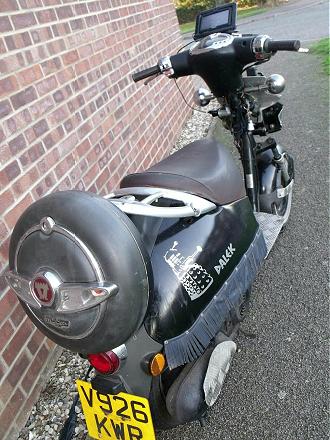
The Yesterday main body shell seemed particularly voluminous and ugly, like some old Edwardian lady wearing a bustle, so out came the jigsaw to cut the body depth back to the bottom of the fuel tank.
With battery connections coming out of the wiring harness at the headstock, there seemed little point to relocating the battery anywhere else, so the complete housing was simply cut from the original front panel and fixed back into place by welding a mounting bracket forward of the headstock.
The Jamboree Bag rubbish front winkers were replaced with some unknown source Japanese indicators of vastly improved quality, and mounted off the battery frame.
A Dural chequer plate was cut to locate off chassis mountings as a footplate.
The front mudguard was originally fitted with side covers, but since one trim was missing, the assembly panels were replaced with chequer plate mudguard brackets, and a mud flap added to prevent spray being thrown up onto the footplate.
The hydraulic disc front brake master and slave cylinders were serviced back into operation, and seized front fork set overhauled.
All the original rear frame fittings were returned to the bike because there seemed little point in changing these purely for the sake of change, and all these parts needed one another to fit together as an assembly, so the rear mudguard, lights, carrier and spare-wheel box are all original fitments.
The spare-wheel box is really just a decorative comedy styling embellishment, because out of interest, we did try putting one of the wheels inside—and it doesn’t fit! The wheels are too big for the box! The ‘wheel box’ actually only houses the rear indicators, and enough storage space for several king-size pizza’s … well it’s the right shape!
The speedometer drive off the front wheel was completely broken and, since speedometers are not required on machines of less than 100cc, why bother? We just left it out, and the dial was simply blanked off with a piece of black vinyl behind the glass.

The original handlebar nacelle with headlamp and instrument cluster was returned to the bar-set because it was all there and everything else worked, so again, why bother altering stuff just for the sake of change?
The rear hub needed new brake shoes, tyre, and a new shock absorber unit fitting because the damping was gone, then with all the electrics and controls now working, the Malaguti was becoming intended to be the new Mopedland workshop hack bike, and to succeed the old Kerry Capitano.
The Capitano also doubled-up as one of our camera bikes for event filming, so the Malaguti would also need to adopt this role, and required a forward video camera mount, which was bolted to the front chequer plate. Dawn commented that the camera mount made it look like a Dalek, so Dalek graphics were made up by Neil Bowen at Walton Works, and applied to the rear panels, so now it’s known as … The Dalek!
A second low-angle camera mount was fitted to the back of the left-hand footplate, to develop filming of bikes from the side while passing.
Chris (Moped Doctor) Day then suggested fitting a SatNav mount so Dalek could be further used as a pace bike for road tests, so a frame was fabricated to bolt to the top of the handlebar nacelle, then a 12-Volt power socket fitted to the left of the steering head and spliced into the wiring harness. A dual-output USB socket allows voltage to be tapped off to drive a TomTom SatNav, and power the forward camera. The footplate camera runs off its own internal battery, but the two batteries can be changed over between the cameras at the mid-point of a run to ensure charge is maintained in the footplate camera.
The only cosmetic addition to Dalek came about when Chris took the scooter out for its first real test ride and, watching him go past on the road, we thought: that bike looks awful! What it needs to finish it off is leather tassel fringes around the bottom of the rear body shell—perfect!
Subsequently now MoT’d, insured, and taxed, our Dalek is everything we want it to be, fully operational, and bristling with all the technology to serve our purpose. Dalek may not be pretty, stylish, or fashionable, but it is certainly functional, interesting, and though we got the bike for free, the new battery, rear tyre, shock absorber, brake linings and brake light switches cost a total of around £80.
Now it’s probably time to take our Dalek out for test ride and see how it goes, and we presume it might go slightly better than standard because a previous owner appears to have cut the disrupter off the exhaust pipe and blanked it off, but we don’t know if anything else might have been done?
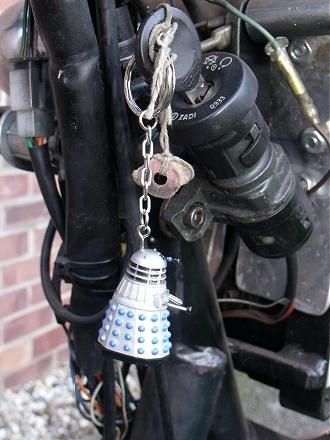
All we can say is the Minarelli 2-CV motor is definitely still 49cc, with its standard 40mm bore × 39.2mm stroke, 12:1 compression ratio, and Dell’orto PHVA 12mm carburettor, with reed-valve induction direct into the crankcase.
In 1990 Minarelli began an association with Yamaha to start production of scooter engines and complement its existing 50cc and 125cc motor cycle engine ranges. This resultant 2-CV horizontal scooter engine design came about from the technological blend of the best Italian and best Japanese two-stroke engineering. Minarelli was completely taken over by Yamaha in 2002, who had also completed the acquisition of MBK (formerly Motobécane in France) by the close of the 1980s so, as part of the group, Minarelli also came to supply the 2-CV motor to MBK for use in its range of 50cc scooters, the only difference being that the French installation was fitted with a Gurtner PY12mm TK 4FK carburettor in place of the Dell’orto. Yamaha still has a liquid-cooled evolution of this original engine in production today as the Aerox, which is often referred as the best 50cc scooter engine ever made.
Dalek’s wheels are cast alloy, fitted with tyres sized 110/90 × 10.
Starting practice is much the same as all modern scooters, turn on the ignition switch, in this case, and now generally, mounted off the steering head by most manufacturers, so the same switch can double-up to operate as a steering lock. You may prefer to exercise your right leg on the kick-start by standing off the left-hand side of the bike, but generally if the electric starter works, most people are going to opt for the easy option. Pull on either brake lever to enable the starter relay, and then just push the button.
The vacuum fuel tap is automatic, as also is the Bi-starter choke, and the motor usually fires up after a couple of spins. Bi-starter choke systems generally demonstrate better throttle response in the initial phase than most other choke start-up methods, but full engine performance is still unlikely to be expected until the engine becomes thoroughly hot.
Opening the throttle finds engine revs rising surprisingly higher than expected before the automatic clutch snaps in quite decisively and launches us into action.
There’s all manner of ‘tuning’ available for modern CVT systems, and we have no idea if our Minarelli engine might be running standard parts, or some partial … or complete … ‘performance’ kit.
Modern CVTs have the variator set driven direct off the crank, with the drive belt constant running to the spring-loaded re-active cone set and automatic clutch at the back.
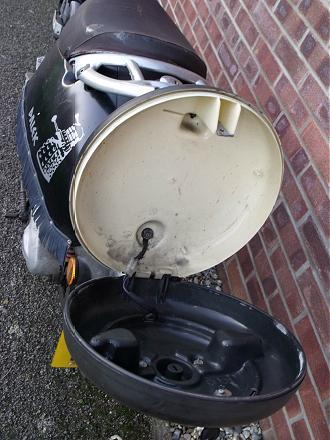
Stronger clutch springs or lighter weight shoes mean engine revs can be higher before the clutch comes in, giving more acceleration power.
Variator action is also tuneable by lighter rollers which allow the engine to run higher driving revs before the ratio changes up, again giving more acceleration power throughout the variator range.
All these factors only affect acceleration and power within the variator range. Final drive ratio and top speed will remain unchanged.
Variator ranges are sometimes governed by manufacturers fitting ‘collars’ between the variator cones to limit the upper ratio range, and so restricting top speed according to market specifications—our Malaguti certainly has no limiter collar in the variator, but we don’t know whether it might have originally even been fitted with one? (It most probably was.)
Since Dalek uses a SatNav for pacing, rather than a speedometer, this doesn’t illustrate acceleration in a linear manner like a needle on a dial. The SatNav displays momentarily changing numbers, and its reading only really settles at a maintained pace.
Dry weight of the bike was originally given as 79kg (12st 6lb), so the Yesterday represented quite a lump for the motor to shift, but you can certainly feel the acceleration kick when you wind open the twistgrip. Its revs and power come in with a bang, and is readily enough to lift the front wheel on throttle. Dalek may look like a rolling junkyard, but the unexpected way it performs is often a surprise for accompanying riders, who frequently enquire whether it’s 125cc. Dalek genuinely is still 50cc, but has certainly benefited from on-going engine development of some the better modern two-stroke scooters, which has continued on and beyond machines as presented in the New Generation article.
Within urban limit speeds, the tassels skirting the rear bodywork begin to flutter, so much to everyone’s amusement, the Dalek suddenly looks like some demented jellyfish pulsating along the road. 30mph comes up easily for this bike, and there’s plenty more throttle on tap to carry it on and beyond the 30 marker. There seems to be a lot of revs involved right from the pull-off, which continue up through the variator range, so it’s difficult to judge at what point the variator range actually runs out and top ratio is achieved.
Still fitted with its original silencer, the exhaust note changes only from a smooth strumming beat on tick-over, up to a smooth and mellow hum under throttle, though the sound is also boosted by a certain amount of suppressed induction draw from the air box.
Hold on the throttle and Dalek easily pulls up to 40mph+ along the flat in upright stance, crouching down coaxes another couple of mph on top, typically seeing 43–44mph on the SatNav, while our best downhill run so far has recorded 47mph.
Dalek insolently deals with uphill climbs with little loss of speed, so much so that we even tried starting from a standstill at the bottom of our test hill, and it simply accelerated up from the bottom to crest the rise at 36mph.
Modern scooters may have largely developed into amorphous lumps of soulless plastic, but what some of the better good 50cc two-stroke engines are capable of delivering in terms of unrestricted performance is quite remarkable by comparison to old mopeds of the ’50s and ’60s. The 50cc engine has sure come a long way…
In the case of the Minarelli 2-CV engine in our Malaguti Yesterday, the performance may seem to come at a heavy cost to the fuel consumption. The fuel tank has an unexpectedly large capacity, which is specified as 9 litres with a 3-litre reserve, and needs filling to the brim to indicate full on the gauge. When you’ve got a full tank, the fuel doesn’t, however, seem to last long, because Dalek proves to have a very thirsty appetite!
The way our Dalek revs so much on take-off and under acceleration, it seems possible it might have had some sort of sport clutch kit fitted, and a lightweight roller set in the variator, so shutting down the throttle almost immediately causes the clutch to disengage, and straight away the bike is freewheeling with no engine braking effect, so you’re constantly riding on the brakes.
The brakes are a whole lot more effective than most of the machines we ride, and prove really useful in confidently knowing that you can haul the bike down from speed. The 155mm disc front brake is only a single pot calliper, and the rear drum 110mm, but the physics of small diameter wheels multiply the braking effect to be well within the capabilities of the scooter.
The wide & small diameter tyres may feel slightly strange when you first ride them, but confidence steadily builds as you acclimatise. The bike can handle quite well on relatively smooth roads, but the rear suspension badly lets it down when you find some bumps. Despite being fitted with a new rear suspension unit, the spring appears underrated and the damping isn’t firm enough, so the back end of the bike can become unsettlingly bouncy on bumpy surfaces.
When one considers that the latest Aerox liquid-cooled scooters can now come with fuel injection, four-pot calliper disc brakes and ABS, the seemingly advanced technology on our Dalek already looks like it came from the Stone Age!
Despite being equipped with a 12-Volt electrical set, it was most surprising to discover that our Yesterday only came with just a 15-Watt single filament headlamp bulb socket. The lights are simple off–on with no beam–dip, and the headlamp proves miserably dim for riding in the dark! It’s still only 15-Watt, and works direct off an AC generator coil with no rectified support from the battery set, so the headlight is practically no different from a 1960s’ Raleigh Runabout.
Usage at events has shown the Dalek to be an exceptionally stable camera platform, giving the best footage of runs that we’ve ever filmed.
It hasn’t however had the opportunity yet for any use as road test pace vehicle, because most of the machines we’ve been testing since getting the Dalek on the road have been a succession of spirited Italian sports 50s, which despite its established performance, all proved too fast for our Dalek to keep up with!


